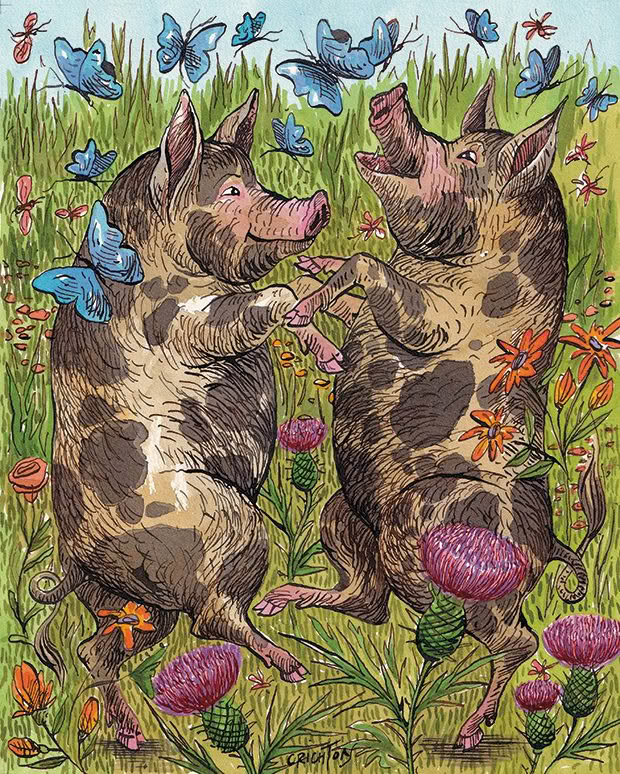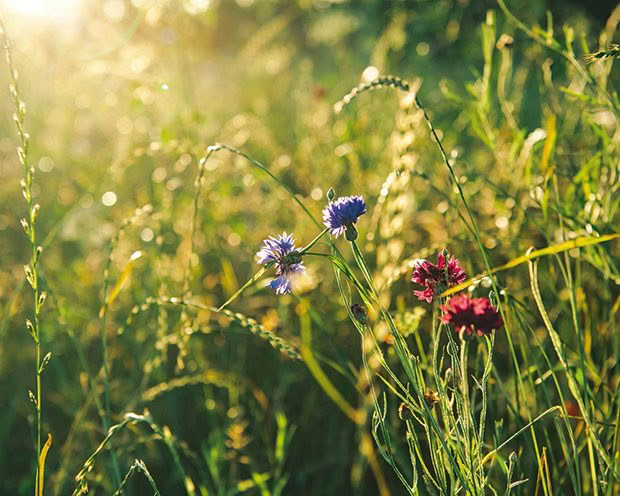Dr Roderick Mulgan: Returning to the wild

Illustration by Anna Crichton
Rewilding — or letting nature take care of itself — is a progressive approach to conservation that is rapidly growing in popularity. But its impact on how this country grows much of its food is enormous.
Words: Dr Roderick Mulgan
Time was that the future of farming was always going to be more of the same: specialised animals and sophisticated chemicals that wring food out of nature at a minimal cost. Well, money cost, that is. The view was that farms make lots of cheap food, so let’s keep going. The modern world is getting jaded with that perspective. Feeding as many people as farms do is an astonishing achievement, which a generation ago, many doubted would happen. But farming cannot continue forever without conserving topsoil, birds and insects, and the world cannot keep going without vegetation that captures carbon. Business as usual has a time limit.
Isabella Tree and her husband, Charlie Burrell, own a farm called The Knepp Estate in West Sussex, England. For years they worked for a loss, mainly due to the stodgy clay soil, and grew nothing more than their overdraft. In 2001, they faced the inevitable and embraced a radically different way of looking at their business. If industrial-grade resource stripping doesn’t work, might collaboration with natural forces do better?
To the dismay of their farmer neighbours (and presumably their bank manager), Tree and Burrell decided to give the farm back. They took out the internal fences (120 kilometres worth), brought in small numbers of old-breed pigs and long-horn cattle and left them to it. Pigs without nose rings rooted up the ground, which, when done by a few pigs and not thousands, turned out to be good for it. Cow dung without worming drugs proved a delight for worms and beetles. Pasture without spray grew legions of thistles (hence the neighbourhood opposition), which brought flocks of insects and morphed over time into woodland. Two decades on, the property is an explosion of diversity. It is Britain’s foremost home of the endangered emperor butterfly, the rare turtle dove, over a dozen species of bat and hundreds of invertebrates, with cows and pigs grazing, breeding and mud-bathing in the same space. Visitors comment on the hum of insects that fills the air; what the world used to sound like everywhere. The process is called rewilding, and it is claiming kudos as the next generation of environmentally sensitive food production.
It’s the same in the Highlands of Scotland, where large parts operate as parks where wealthy people pay to shoot deer. The returns are miserable, so many properties carry more deer than they ought to the apparent detriment of heather, hares, grouse, ptarmigans, and everything else that nature intended to share the space. In an odd twist, unprofitability has proved helpful since rewilding became fashionable, as many of these properties have passed into the hands of buyers with deep pockets who don’t rely on the best possible returns (half of Scotland is owned by 450 people). Some estates have withdrawn their deer (okay, they shot them) so the Glens can flourish again. When the process is advanced, they anticipate bringing guests back who will pay to walk the paths and marvel at nature rather than blow it away. With old malt and a fir-wood fire afterwards.
Letting nature get on with it is not novel. It is the modus operandi of numerous conservation projects, including a few inadvertent ones. The territory around the Chernobyl nuclear meltdown has blossomed with wildlife since people withdrew, as has the demilitarised zone between North and South Korea.
That includes everything up to megafauna, such as bison in Chernobyl and bears in Korea. Take the humans out, and nature bounces back, often with alacrity. The issue is whether it can be done without relinquishing economic returns.
And this is the elephant — or the long-horn heritage breed cow — in the room. Can rewilded spaces pay? Converting a meaningful chunk of the world’s arable territories into new Edens of cooperating trees and old-breed animals will only happen if the farmer grows something useful to sell, and enough of it.

Much farming operates on paper-thin margins, and there is little scope for vanity projects. Farmers must pay bills too. Meat from these projects could charge a premium to well-informed customers, but it is questionable whether this would compensate for loss of volume.
Conventional farms teem with sheep and ripple with wheat to the horizon, usually where forests once stood, because bulk outputs are economic, and rewilded farms compete in the same market. Digging into the Knepp experiment indicates that it is famous in environmental circles, and guests who pay to stay there are a large part of what keeps it viable. That is not a model scalable to thousands of iterations. Yet 40 per cent of the planet is farmland, and most of that concerns animals; better ways of doing business are urgently needed.
The compromise might be wilding themes plastered on conventional meadows. Pulling back on weed sprays and stocking densities are useful steps. Wildflower strips and hedgerows can dramatically increase options for wildlife without giving the whole enterprise over to nature. Likewise, planting without ploughing and fertilisation via nitrogen-capture crops (lupin, clover), not a chemicals truck.
Other options are more innovative. Some farmers in Britain are reintroducing beavers to their streams. British beavers were commonplace until they were hunted out the door in the 16th century.
The thinking behind bringing them back is that beaver dams will not only create natural wetlands, which will become their oases of plants and insects, but will stop unseasonal rain cascading unimpeded to the nearest flood plain, which, just like here, is an ongoing worry.
It is likely to come down to subsidies. New Zealand is rare in expecting farmers to pay their way. Most countries pay farmers subsidies, traditionally justified as delivering cheap food and guardianship of the countryside. Perhaps payments could be calibrated to more than the annual tonnage of mutton and potatoes in the future. Since the UK withdrew from the European Union, it became responsible for its farming subsidies and, therefore, can redesign them.
On 11 November 2020, a statute called the Agriculture Act 2020 received royal assent. Traditional subsidies for land holding and output will be progressively withdrawn and gone completely by 2028. New subsidies will be available to farmers who sign up for specified animal welfare and environmental protection initiatives. If it works as intended, agriculture will become a very different beast from its history and tradition.
If so, we might also have to rethink our approach in this part of the world. It is one thing to expose farmers to the make-or-break forces of the free market when the only issue is what they grow to sell. But if we step back and recognise that a large part of the biosphere lies within their industry, paying from the public purse for land to be managed more sensitively seems more reasonable. There is more to farming and human welfare than the cheapest possible bread and beef.
For a full account of Knepp Farm, see Wilding: The Return of Nature to a British Farm, Isabella Tree, Pan Macmillan.
REFERENCES
• Rewilder, Isabella Tree: “One day we won’t need nature reserves.” Battle, L. Financial Times, 9 July 2021.
• The End of Farming? Belliague, C. The Guardian, 25 February 2020.
• Review of Wilding by Isabella Tree — How a Farm Returned to Nature. Henderson C. The Guardian, 28 June 2018.
• See impact.economist.com/projects/foodsustainability/blogs/can-rewilding-and-farming-be-combined-to-build-a-better-food-system/
• The End of Farming? Belliague, C. The Guardian, 25 February 2020.
 This article first appeared in NZ Life & Leisure Magazine.
This article first appeared in NZ Life & Leisure Magazine.
